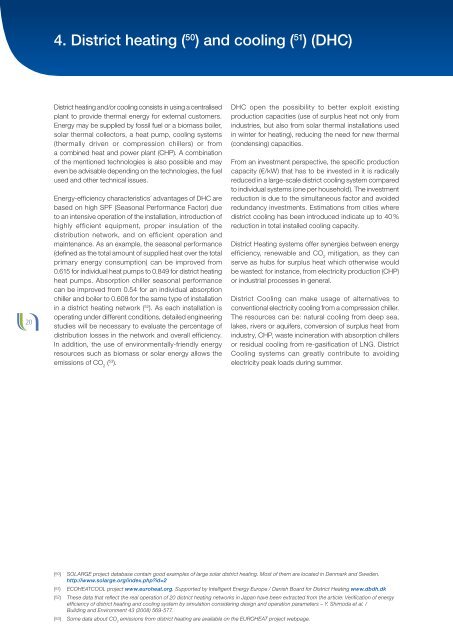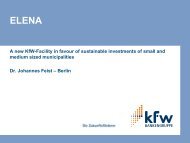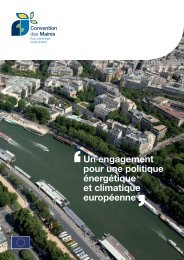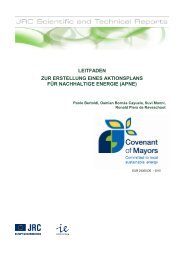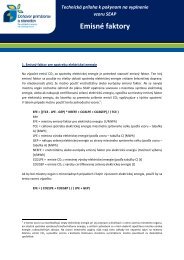English - Covenant of Mayors
English - Covenant of Mayors
English - Covenant of Mayors
You also want an ePaper? Increase the reach of your titles
YUMPU automatically turns print PDFs into web optimized ePapers that Google loves.
4. District heating ( 50 ) and cooling ( 51 ) (DHC)20District heating and/or cooling consists in using a centralisedplant to provide thermal energy for external customers.Energy may be supplied by fossil fuel or a biomass boiler,solar thermal collectors, a heat pump, cooling systems(thermally driven or compression chillers) or froma combined heat and power plant (CHP). A combination<strong>of</strong> the mentioned technologies is also possible and mayeven be advisable depending on the technologies, the fuelused and other technical issues.Energy-efficiency characteristics´ advantages <strong>of</strong> DHC arebased on high SPF (Seasonal Performance Factor) dueto an intensive operation <strong>of</strong> the installation, introduction <strong>of</strong>highly efficient equipment, proper insulation <strong>of</strong> thedistribution network, and on efficient operation andmaintenance. As an example, the seasonal performance(defined as the total amount <strong>of</strong> supplied heat over the totalprimary energy consumption) can be improved from0.615 for individual heat pumps to 0.849 for district heatingheat pumps. Absorption chiller seasonal performancecan be improved from 0.54 for an individual absorptionchiller and boiler to 0.608 for the same type <strong>of</strong> installationin a district heating network ( 52 ). As each installation isoperating under different conditions, detailed engineeringstudies will be necessary to evaluate the percentage <strong>of</strong>distribution losses in the network and overall efficiency.In addition, the use <strong>of</strong> environmentally-friendly energyresources such as biomass or solar energy allows theemissions <strong>of</strong> CO 2( 53 ).DHC open the possibility to better exploit existingproduction capacities (use <strong>of</strong> surplus heat not only fromindustries, but also from solar thermal installations usedin winter for heating), reducing the need for new thermal(condensing) capacities.From an investment perspective, the specific productioncapacity (€/kW) that has to be invested in it is radicallyreduced in a large-scale district cooling system comparedto individual systems (one per household). The investmentreduction is due to the simultaneous factor and avoidedredundancy investments. Estimations from cities wheredistrict cooling has been introduced indicate up to 40 %reduction in total installed cooling capacity.District Heating systems <strong>of</strong>fer synergies between energyefficiency, renewable and CO 2mitigation, as they canserve as hubs for surplus heat which otherwise wouldbe wasted: for instance, from electricity production (CHP)or industrial processes in general.District Cooling can make usage <strong>of</strong> alternatives toconventional electricity cooling from a compression chiller.The resources can be: natural cooling from deep sea,lakes, rivers or aquifers, conversion <strong>of</strong> surplus heat fromindustry, CHP, waste incineration with absorption chillersor residual cooling from re-gasification <strong>of</strong> LNG. DistrictCooling systems can greatly contribute to avoidingelectricity peak loads during summer.(50) SOLARGE project database contain good examples <strong>of</strong> large solar district heating. Most <strong>of</strong> them are located in Denmark and Sweden.http://www.solarge.org/index.php?id=2(51) ECOHEATCOOL project www.euroheat.org. Supported by Intelligent Energy Europe / Danish Board for District Heating www.dbdh.dk(52) These data that reflect the real operation <strong>of</strong> 20 district heating networks in Japan have been extracted from the article: Verification <strong>of</strong> energyefficiency <strong>of</strong> district heating and cooling system by simulation considering design and operation parameters – Y. Shimoda et al. /Building and Environment 43 (2008) 569-577.(53) Some data about CO 2emissions from district heating are available on the EUROHEAT project webpage.


